Toshiba Satellite A660D-ST2G01: AMD's Quad-Core Phenom II P920 Joins the Mobile Party
by Jarred Walton on August 31, 2010 12:45 AM ESTToshiba A660D-ST2G01 Gaming
As with our Studio 17 review, we'll start with a look at low-detail 1366x768 gaming performance first. This is an apples-to-apples comparison of the various systems, but the A660D is definitely able to handle higher detail settings at native resolution. We'll look at medium and high quality gaming next. We've also included results from the Acer 5740G where we have them, but we didn't have some of the newer titles around at the time of that review, and we used a different driver (Catalyst 10.3 at the time).
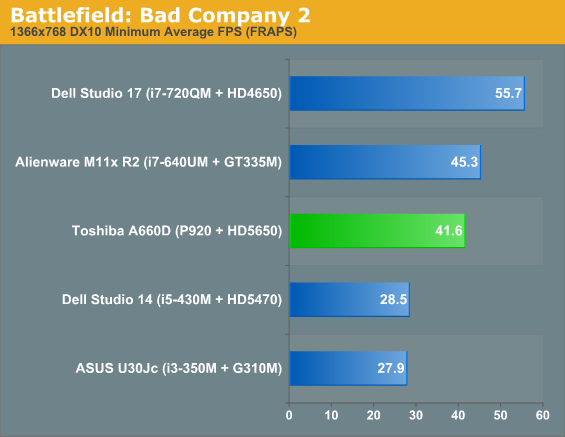
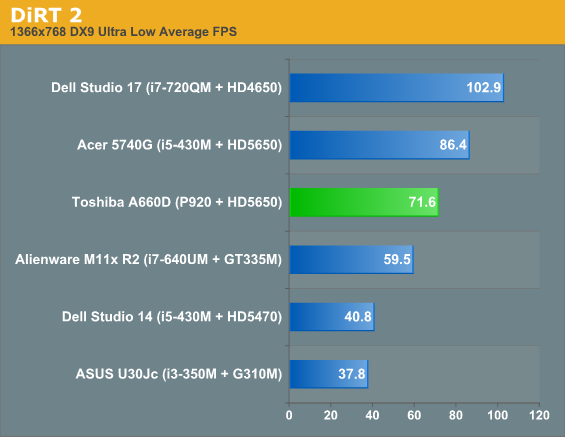

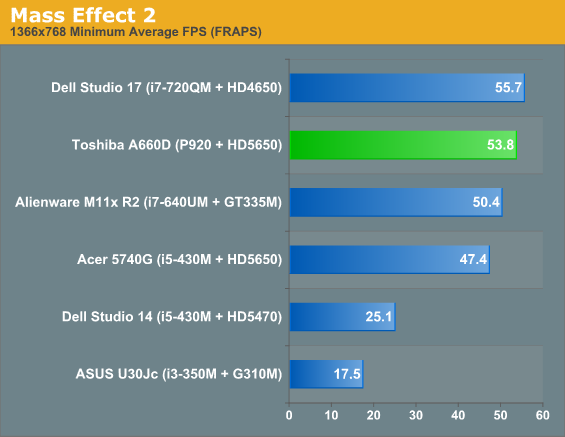
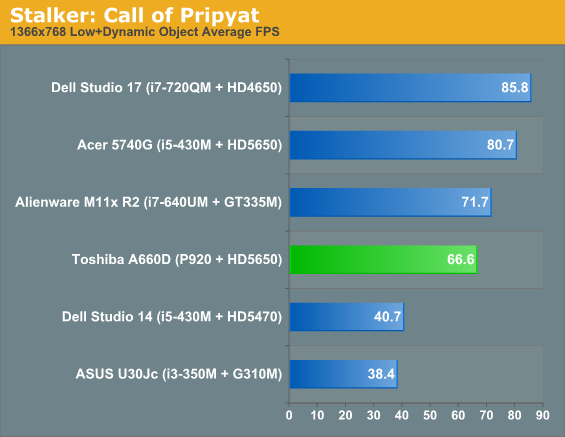
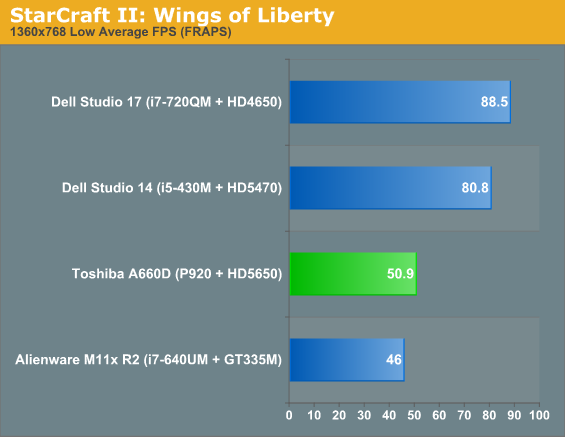
For our new set of games, our low quality settings are all easily playable. That said, it's interesting to note where the A660D falls relative to the HD4650 in the Studio 17 and the faster clocked 5650 in the 5740G. Obviously the i7-720QM is a faster CPU, and that helps, but it's still disconcerting to see the last generation midrange GPU beating the A660D by an average of 35%! The only close score is in Mass Effect 2, where the lead is only 4%, but that's balanced by a lead of 74% in StarCraft II—a game that tends to be quite demanding on the CPU when there are lots of units running around. The Acer 5740G also leads by around 21%, right in line with the GPU core clock advantage; oddly, Mass Effect 2 ran 13% slower on the 5740G, so for some reason that particular title likes the A660D.
Also something to note is that we did test gaming performance with both the shipping ~10.4 era drivers as well as the latest 10.8 AMD drivers. The latter were only faster in DiRT 2, and then only by around 5%. We elected to use the best-case result for the A660D in all of the charts, but outside of DiRT 2 the drivers scored within 1% of each other.
We did look at some of our older gaming results as well just to get a larger view of the gaming landscape (sorry, no graphs here). The Acer 5740G continued to score around 20-30% higher in most titles, going along with the GPU clock speed difference and the faster i5-430M CPU. However, we're still looking at "Low" quality gaming, so let's move to a more realistic "Medium" setting.
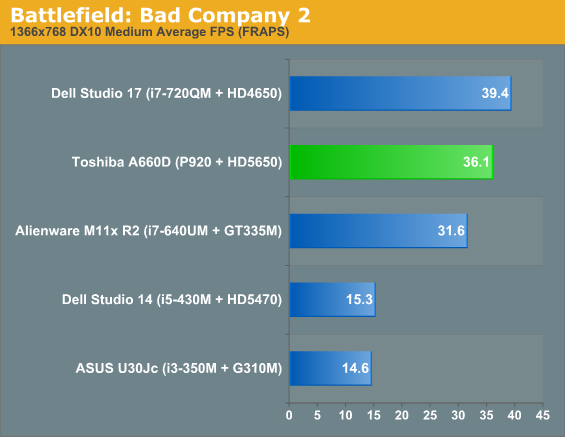
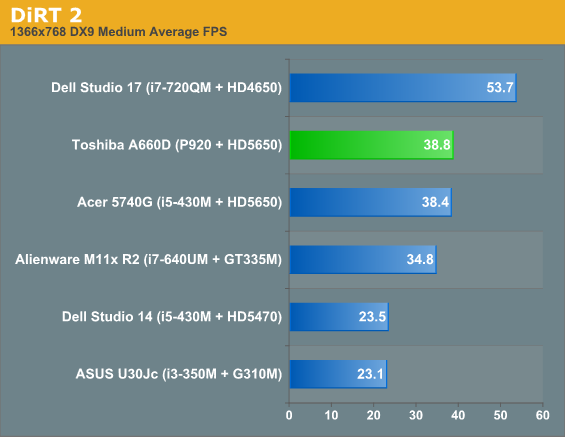
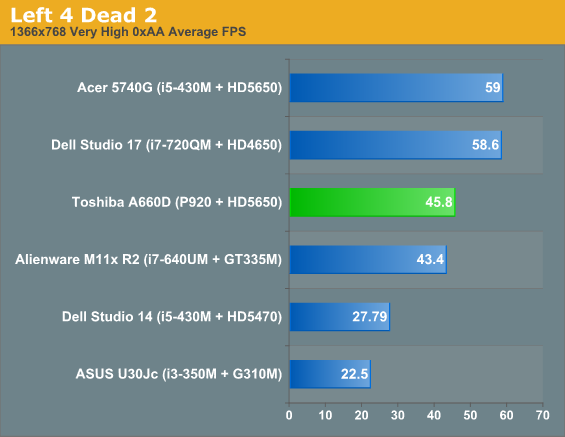
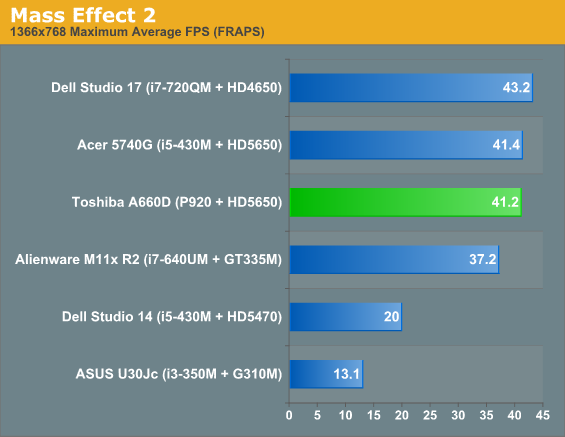
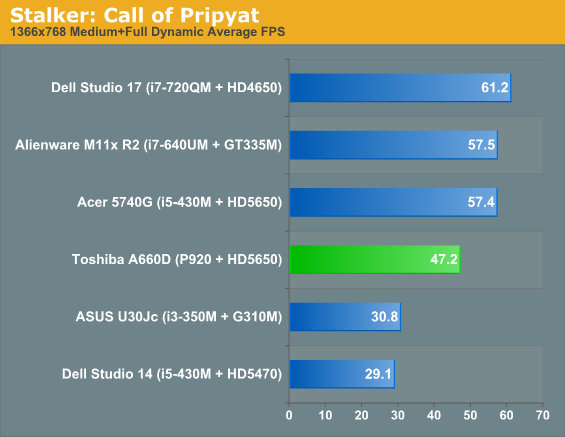
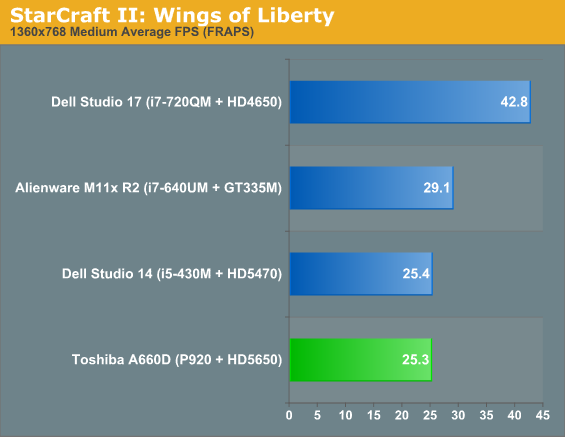
The earlier results generally hold, though now we start to see a few games dip into frame rates that are a bit lower than we'd like. StarCraft II is the big drop, with a score of just 25.3 FPS at Medium quality defaults. There's a combination of CPU and GPU requirements in SC2, particularly in intense battles like our FRAPS demo, and the low 1.6GHz CPU clock looks to be a bottleneck. The Studio 17 is now averaging 30% faster than the A660D, down slightly from our low results, and the 5740G is 12% faster—or tied in two games, and 20-30% faster in the other two samples. Medium quality is where the A660D does best, striking a nice blend of performance and graphics quality, but we can't help but wonder what the numbers would have been with a higher clocked P520 processor.










33 Comments
View All Comments
JarredWalton - Tuesday, August 31, 2010 - link
My Google-Fu was obviously weak. This is the only P520 + 5650 laptop around right now it seems, and we are working with AMD to get one. Acer likely will clock the 5650 at the full 550MHz as well, which would make it a lot more interesting.silentim - Tuesday, August 31, 2010 - link
Hi, nice review. Glad to see AMD back to the game. Intel need competition these days.I m sorry for being off-topic here, but I can't find any anandtech official email. I'd like to ask for review for system76, one of few OEM other than Apple to ship consumer laptop other than windows, ubuntu in this case. I want to have references where I can buy laptop without m$ tax other than overpriced Apple.
JarredWalton - Tuesday, August 31, 2010 - link
jarred.walton@anandtech.comanand@anandtech.com
dustin@anandtech.com
vivek@anandtech.com
ryan.smith@anandtech.com
One of those should work. ;-)
Cal123 - Tuesday, August 31, 2010 - link
Nice review btw, I thought it was objectively done. The only important thing I could think of to possibly add would be temp readings under load for cpu and gpu, to make sure the cooling system was up to snuff.andrewaggb - Tuesday, August 31, 2010 - link
I seriously considered getting one of these laptops about 2 weeks ago, until I realized it didn't have amd's version of turbo boost/core. One quick look at some starcraft cpu benchmarks made me realize I would get half the frame rate of the i7-720qm. I also wasn't sure if toshiba let you use amd's laptop drivers, which you say they don't. I got a gateway one instead for $200 more, but it has the intel quad core and you can use amd's drivers. No regrets. 50% slower frame rates just wasn't worth it.Roland00 - Wednesday, September 1, 2010 - link
AMD would be competive to Intel if it had turbo and powergating.For example the best 35w AMD processors that AMD currently has are these three models
AMD Phenom II x4 n930 at 4x2.0 ghz
AMD Phenom II x3 n830 at 3x2.1 ghz
AMD Phenom II x2 n620 at 2x2.8 ghz
Now compare that to intel i7 720qm which works as follows with turbo (note this is a 45w processor)
1.6 ghz Quad Core no turbo
1.73 ghz Quad Core with turbo
2.40 ghz Dual Core with turbo
2.80 ghz Single Core with turbo
If AMD had turbo and power gating it would not be unreasonable that the n930 could act as a 2.0 ghz quad core and a 2.8 ghz dual core. Thus if we are comparing straight ghz amd would possess 25% more ghz as a quad core with no turbo, 16% more ghz as a quad core, and 16% more ghz as a dual core. Now comparing ghz from different architectures is foolish for they are not the same thing, that said intel i7 mobile has a higher ipc than the phenom II mobile (which is a variant of the Athlon IIx4 of Desktops). That said the higher ipc of intel vs the higher ghz of AMD would put them real close in final speed (intel may win the benchmarks, but ask a person to "feel the difference in speed" and they would be hard pressed to differentiate.)
Sadly AMD has no turbo or powergating thus it won't be comparable. Rumors say llano will have these features, thus that is good news for AMD, but then AMD will be competing against mobile Sandybridge which will be 10-30% faster compared to Nehalem.
LaptopDoctor - Wednesday, September 1, 2010 - link
I own and operate a laptop repair business and after reading months of comments in various articles where folks are trying to justify AMD's recent poor performance, I thought I would throw in my two cents. Over the past 2-3 years I observed (and fixed) a 12 to 1 ratio of AMD based failures to Intel...mostly because of over-heating and chipset failures (HP's DV series is a great example). Seems like the vendors are trying to make AMD products compete at the mid to higher levels in thermal packaging which can't hold up much past the limited 12 month warranty. Guess this is why you can't find a ThinkPad (T-Series) with an AMD solution inside it. Unfortunately the consumers purchasing the Toshibas and HPs in this price range are really the ultimate loosers. It would be interesting for this forum to take a look at longivity in addition to speed. A fast laptop that lasts 12.5 months is a bad investment regardless of how many frames per second it can do!!!The Crying Man - Wednesday, September 1, 2010 - link
Can you specify the most common AMD CPUs? I have an HP L2005CM with a Turion 64 that's still running after 4 years with the first 2 years seeing heavy use. Curious if my CPU is part of that or if it's more with the Turion Ultras that came out after.LaptopDoctor - Thursday, September 2, 2010 - link
In most cases it is a HP, Compaq, or Toshiba with Turion 64 based system with Nvidia chipset...best examples are HP DV2000,DV6000,DV9000,Compaq F500/700 series etc. But in general it is in the retail packaging versions commonly seen and sold at local retailers in the $450-800 price range. When you get inside them the quality, fit, finish - especially with the heatsink/fan and venting, point out obvious issues. Little foam pads to make up for poorly fitting heatsinks, etc. The really sad part is that if you had an unmarked Acxx or Asxx open next to a Tosxxx or Hxx (any model except their commercial machines), you would wonder what happened to American and Japanese quality. Sort of reminds you of when Honda and Toyota taught GM and Ford what quality meant. You can observe the same issues when you lay a ThinkPad or Sony heatsink/fan assembly down next to a Dell Inspiron/XPS counterpart. After the 12 month warranty is gone, you really find out that "you get what you paid for"!! I just finished taking a CQ62 apart to remove a piece of tape that was supposed to hold the wires away from the fan, instead it was acting like a mini noise maker when the fan ran....they used to route those wires in a channel so this would not happen...now it's scotch tape. Guess this site caters to "gamers" who are only concerned about how fast it will run Crysis for the next 6 months....but then again, high failure rates in the 12-20 month range is great for my business.DanaG - Thursday, September 2, 2010 - link
"Nvidia chipset" -- remember nvidia's bumpgate fiasco?But yeah, it's always sucked that manufacturers include weak GPUS with AMD processors. It really reflects badly upon AMD.
Also Toshiba fail for not offering DisplayPort. No DisplayPort means you can only use two displays at once.
Anything with Evergreen and DisplayPort should allow three displays at once.
DP->VGA adapters are a mere 25 bucks, and the single-link DP->DVI adapters should be 30, soon.